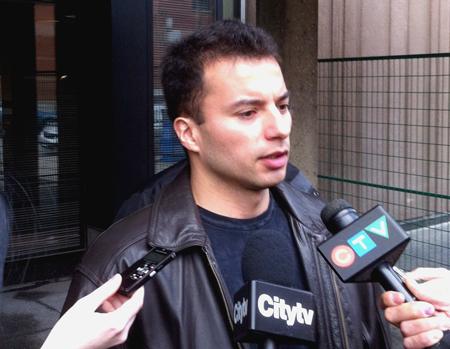UPDATED MARCH 14: The coroner’s inquest into the death of James Hearst closed March 13 with jurors returning 29 recommendations to the City of Toronto, Ministry of Health, and Toronto Emergency Medical Services to ensure that similar deaths do not happen again.
Hearst died of a heart attack June 25, 2009, in the hallway of his Alexander St apartment complex while waiting almost 40 minutes for emergency medical services. His death drew widespread attention and criticism of the actions of the paramedics involved, who decided to stage their response around the corner out of view of the building. There was speculation that their delayed response was due to the 2009 civic workers’ strike, although all involved have denied that they purposely delayed their service because of the labour action.
Jurors, who heard six weeks of testimony in the long-delayed inquest, did not make any recommendations relating to the availability of EMS during a strike; however, they noted that the city has concluded an agreement with its unions whereby all paramedics and 95 percent of emergency medical dispatchers will continue to work in the event of a labour stoppage.
They did recommend that the city “ensure that there are no unjustifiable preventable delays . . . for any reason” in the provision of EMS.
Coroner’s counsel Stefania Fericean says the evidence does not point to the labour action having anything to do with the delay that caused Hearst’s death.
During the inquest, it was established that Local 416 EMS unit chair Glenn Fontaine had sent an email during the strike urging paramedics not to “compromise patient care by rushing.” It was initially speculated that the email was interpreted as a labour slow-down directive that may have influenced the delayed response, but the first responders and dispatcher involved denied receiving the email.
Fontaine’s email was never made public. He resigned from the EMS earlier this year before testifying at the inquest.
“There was no direct link between the strike activity and the actions of the paramedics in this case,” Fericean says.
But Hearst’s surviving partner, Alejandro Martinez, is not convinced.
“I cannot say 100 percent positive that the strike did not play a part,” he says. “I will still try to look on my own for more information about it.”
Other Ontario municipalities do not have essential-service designation for their EMS. Although the inquest was largely about circumstances in the city of Toronto, the verdict will be forwarded to all hospitals, municipalities and emergency medical services in the province.
“It’s up to [other municipalities] whether or not they want to comply with the recommendations,” Fericean says.
The jury’s recommendations largely deal with the string of events that emergency responders say led to the delay in service.
The Ministry of Health and Long-Term Care is recommended to train dispatchers to ask every caller, verbatim, “Okay, tell me exactly what happened.” The initial dispatcher in the Hearst case did not get clear information from the first caller, leading him to misclassify the call as “unknown trouble” and to note incorrectly that Hearst “had been drinking” when the caller told him “he looks like he might be drunk.”
The jury recommends a much clearer distinction between “unknown medical problem” calls and “unknown trouble” calls. Unknown trouble suggests that there may be safety issues on the scene and police assistance is required before paramedics go on scene, whereas police should not be called to “unknown medical problem” calls, the jury recommends.
Paramedics testified that they decided to stage because they were waiting for police to arrive on scene.
The jury recommended that EMS clarify the standard operating procedure around staging, including clearer chain of command, a requirement to document all staged responses, and a requirement that paramedics give clear reasons for any staged response.
Toronto EMS has already implemented changes to the standard operating procedure in the wake of initial reports into Hearst’s death. Since 2010, supervisors have been required to attend the scene of any staging incident.
“What the jury has done is to enhance . . . and clarify those protocols to address the fact that some of the paramedics who testified in this inquest appeared to have some lingering concerns about how to actually implement the protocols that have been put into place,” Fericean says.
“The paramedics now have specific requirements to articulate the reasons for their staging, and also there’s a great deal more emphasis on communication between paramedics and their supervisors and the communication centre to ensure that there’s more supervision in the event of a staging,” she says.
The jury also recommended more on-the-job training for paramedics, including specific training for staged responses and assigning newer recruits with more experienced paramedics.
Hearst’s death has already been the subject of an inquest by the Ministry of Health and Long-Term Care, which concluded that five EMS staffers made serious errors, including not following proper procedures. Those staffers were reprimanded but kept their jobs.
Toronto’s EMS chief Paul Raftis says he will give “full consideration” to the recommendations of the jury, even those that may lead to additional costs for EMS.
“We’re going to do a full review of the recommendations,” he says. “We fully implemented the Ministry of Health recommendations. The city manager recommended 10 changes to be made and we fully implemented those.”
For Martinez, who has attended every day of the inquest, the jury’s recommendations are little comfort for the loss of his partner of eight years.
“I’m glad that my partner’s death is helping to improve the service that EMS is going to be providing to the people of Toronto, but I ask myself, Was it necessary for my partner to die for them to realize the huge holes they had in their system? I don’t think so,” he says.
The coroner’s inquest could not assign guilt but is charged with issuing recommendations to prevent future deaths.
“I think that my partner’s death was way more valuable than just for people who testified to not doing the job that they were supposed to do, that they just get a simple reprimand, while my partner will be dead forever,” Martinez says.
Read the jury’s recommendations below:


 Why you can trust Xtra
Why you can trust Xtra


